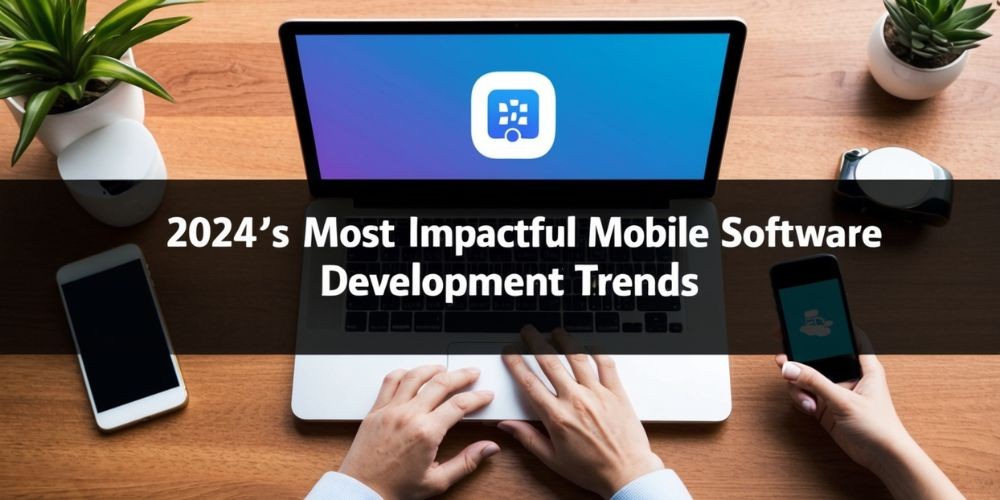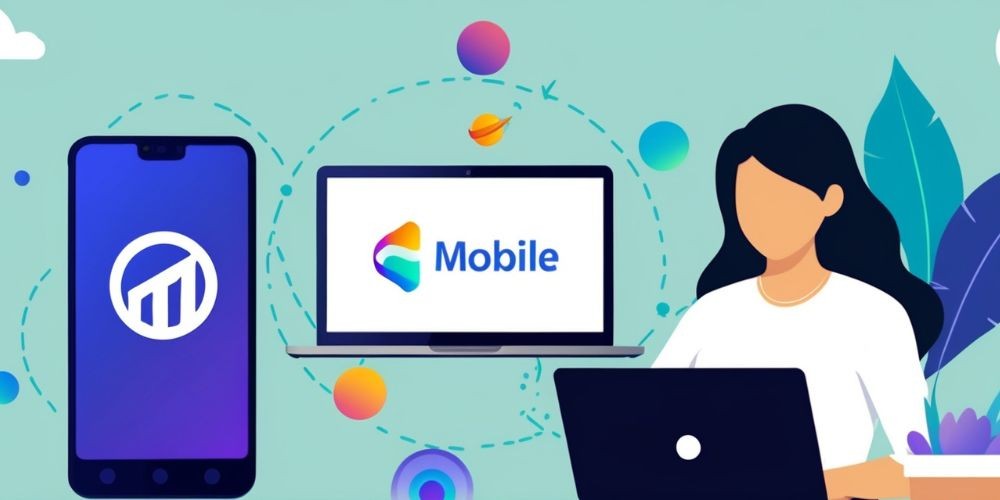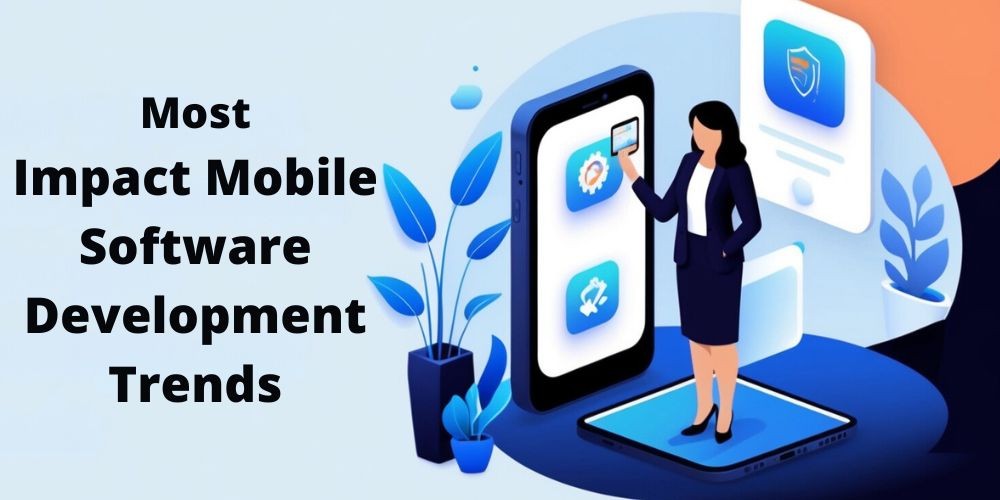2024's Most Impactful Mobile Software Development Trends
- Jul 29, 2024
- 1105

The mobile software development scene is advancing faster than ever. As billions of mobile devices are utilized worldwide, developers are pushing the boundaries of innovation by crafting applications that are increasingly interactive, efficient, and secure. As we enter 2024, several key trends are emerging that promise to redefine how mobile apps are developed and used. This article delves into the top development trends and their influence on the mobile app industry.
AI and ML: The Standard Components
Artificial Intelligence (AI) and Machine Learning (ML) have transitioned from being trendy terms to becoming cornerstones in mobile app development. These technologies now play essential roles, offering considerable advantages. Forecasts indicate that the AI market is set to reach an incredible $1,345.2 billion by the end of the decade. But why are AI and ML so crucial to modern mobile applications?

AI and ML facilitate the analysis and processing of massive data sets, enhancing the user experience. AI can offer personalized content recommendations, similar to Netflix. ML enables apps to improve over time through user interaction. Examples include predictive text, personalized shopping suggestions, and smart chatbots like Bank of America’s Erica. As users engage with these apps, ML algorithms get better at providing customized content, thus improving user satisfaction.
Generative AI for content creation is also gaining attention. Nevertheless, it's essential to tackle challenges like data privacy, algorithmic bias, and high computational costs. Developers need to balance leveraging AI capabilities with ensuring responsible and secure usage.
Augmented Reality: Merging Digital and Physical Worlds
Augmented Reality (AR) is revolutionizing how we interact with both digital and physical environments. By 2024, Statista predicts there will be 1.7 billion AR-enabled mobile devices globally. With such widespread adoption, AR applications are making significant impacts in industries ranging from retail to education, travel, and healthcare.
Imagine using an app to visualize a piece of furniture in your living room before purchasing it. Apps like IKEA Place and Amazon AR View make this possible. In education, AR apps like Complete Anatomy offer interactive 3D models that enhance learning experiences. Travelers can use apps like Google Translate and Google Lens for real-time translations and landmark information, making their journeys more immersive and informative.

In healthcare, AR’s applications go beyond visual aids. For instance, the Proximie app enables remote surgical guidance and collaboration, bringing real-time expertise into operating rooms. As augmented reality (AR) technology progresses, it will effortlessly blend into everyday life, closing the divide between digital and physical realms.
The Expanding IoT Ecosystem
By the end of 2024, it's expected that over 207 billion devices will be part of the Internet of Things (IoT), according to Forbes. This highlights the extent to which IoT is entering every aspect of daily life, affecting areas such as smart homes, health and fitness, and the automotive industry.
Smart home devices like Google Home and Apple’s HomeKit allow users to control household functions from their smartphones. Health and fitness trackers like Fitbit and Apple Watch offer real-time health data, promoting better personal well-being. Even the automotive sector benefits from Tesla’s app, which allows users to control various car functions remotely, including climate and location tracking.
The expanding IoT ecosystem presents new challenges for developers, who must create applications that are robust, efficient, and secure. Effective communication and strong data security protocols are essential to protect user privacy and ensure device functionality.
Enhanced Security and Privacy
As digitalization grows, the need for strong security and privacy measures in mobile apps becomes more critical. Developers must keep up with evolving cyber threats by implementing advanced security protocols. Adhering to regulatory frameworks like GDPR and HIPAA involves incorporating encryption, multi-factor authentication, and regular security audits.

Security and privacy can also be significant selling points, as many users are concerned about their data. Poor security can lead to severe consequences, such as hefty fines and reputational damage. Therefore, strong security measures are not just a necessity but also a competitive advantage in the mobile app market.
Developing secure applications involves several steps, including secure coding practices, regular vulnerability assessments, and ensuring compliance with applicable regulations. Striking a balance between user-friendly authentication processes and high security is essential for developers.
Cross-Platform Development: Efficient and Wide-Reaching
With businesses aiming to reach larger audiences across multiple devices, cross-platform app development has gained momentum. Technologies like React Native and Flutter allow developers to write code once and roll it out across several platforms, such as iOS and Android. This method not only saves time but also reduces costs.
Large companies like Skype and Walmart have mastered cross-platform development, delivering consistent experiences regardless of the device. The ability to reuse code and share business logic across platforms leads to quicker time-to-market and simplified app maintenance. As more companies adopt cross-platform development, tools and frameworks are maturing, offering enhanced capabilities.
Although cross-platform development has its challenges—such as performance optimization and native feature integration—the benefits outweigh the difficulties, making it a practical choice for many businesses.

Blockchain’s Impact
Although blockchain is frequently linked to cryptocurrencies such as Bitcoin, its uses go well beyond digital money. Blockchain technology offers security, transparency, and decentralization, making it attractive for mobile app development.
The primary advantage is tamper-proof data management, essential for financial transactions and identity verification. Blockchain’s decentralized app (dApp) development services enhance security and accountability. Apps like Coinbase for cryptocurrency trading and VeChain for supply chain management demonstrate blockchain’s potential for more secure and transparent services.
Gartner predicts that by 2030, blockchain-based systems will manage up to 20% of the global economic infrastructure. This trend signals significant opportunities for mobile app developers who focus on blockchain technologies, offering applications that prioritize user trust and security.
Voice-Enabled Interfaces: A Hands-Free Future
Voice-enabled interfaces are transforming how users interact with mobile devices, providing a hands-free, intuitive experience. The convenience of voice technology is becoming an essential feature in modern mobile applications.
Beyond virtual assistants like Siri and Alexa, voice commands are integrated into various app types, including navigation, ridesharing, and home automation controls. This integration offers a more seamless and intuitive user experience.

Incorporating voice recognition APIs into mobile apps requires understanding user intent, optimizing for natural language processing, and ensuring high accuracy. As voice technology evolves, it opens up even more opportunities for intuitive user interactions.
Unlocking the Potential of 5G
The rollout of 5G technology is set to revolutionize mobile app development, offering ultra-fast speeds, minimal latency, and reliable networks. With 5G, developers can create data-intensive applications without being limited by bandwidth constraints, resulting in faster downloads, smoother streaming, and more interactive apps.
To fully leverage 5G, developers should:
- Optimize app speed and performance for faster data rates.
- Enhance media capabilities for better quality videos and images.
- Prepare for seamless IoT integration.
- Smooth out animations and transitions enabled by faster speeds.
- Implement battery optimization techniques to manage 5G’s power draw.
- Upgrade backend systems to handle increased data flow.
- Conduct rigorous testing under varied 5G conditions.
- Stay informed on 5G developments to adapt the app efficiently.
Developing for 5G is more than just using faster data speeds; it involves re-imagining what mobile applications can achieve when network limitations are significantly reduced.
User Experience Design: The Heart of Success

Providing a seamless user experience (UX) is critical to the success of any mobile app. A thoughtfully designed app not only draws users in but also keeps them engaged. Crafting intuitive, responsive, and accessible interfaces is crucial for a satisfying user experience.
Successful UX design involves understanding user behavior and preferences through detailed analytics. This data allows developers to refine interfaces and align them with user expectations. Key elements include intuitive navigation, consistent design language, and responsive touch interactions.
Accessible design ensures usability for people with varying abilities, integrating features like voice commands, adjustable font sizes, and screen readers. Prioritizing user experience enables developers to craft applications that connect with users, resulting in increased engagement and retention.
Mobile Commerce: Shopping Anytime, Anywhere
Mobile commerce (M-Commerce) continues to grow as consumers increasingly turn to smartphones for shopping. Major retailers like Amazon and Walmart, along with smaller direct-to-consumer brands, are investing heavily in mobile commerce to offer personalized and seamless shopping experiences.
Successful mobile commerce apps focus on:
- Security: Ensuring secure transactions through encryption, secure payment gateways, and compliance with financial regulations.
- Personalization: Providing personalized recommendations and targeted marketing to enhance the user experience.
- User Engagement: Simplifying navigation, speeding up checkout, and incorporating customer reviews.
- Omni-channel Integration: Offering consistent shopping experiences across multiple platforms.

Mobile commerce is not just another sales channel; it’s an integral part of the digital economy. By concentrating on these factors, businesses can take advantage of the burgeoning mobile commerce trend and achieve substantial sales growth.
Case Studies: Real-World Success Stories
Artkai, a leader in mobile app development, showcases its capabilities through successful projects like Prop.ly and GoodMatch.
Prop.ly: This platform is shaking up Singapore’s real estate market by connecting property owners with agents. The app simplifies the agent selection process and optimizes property transactions. Through intuitive design and robust features, Prop.ly reflects Artkai’s commitment to solving specific industry challenges.
GoodMatch: Focused on connecting donors and volunteers with nonprofit organizations, this app simplifies community support. Features like micro-donations and grassroots social awareness provide an easy way for users to make a meaningful impact. GoodMatch highlights Artkai’s dedication to creating solutions that matter.
These case studies demonstrate how Artkai leverages current trends to develop innovative and functional mobile applications. By understanding market demands and integrating cutting-edge technologies, Artkai delivers solutions that exceed user expectations.
Conclusion
The mobile app development landscape in 2024 is dynamic and driven by rapid technological advancements and changing user preferences. From AI and ML integration to the widespread use of AR and IoT, the future of mobile apps is full of possibilities. Enhanced security measures and the adoption of cross-platform frameworks ensure that apps are secure, efficient, and accessible. Additionally, the rise of blockchain and voice-enabled interfaces sets the stage for more secure and intuitive user interactions.
The arrival of 5G will significantly boost app performance, offering faster and more reliable experiences. Coupled with a focus on user experience and the growing trend of mobile commerce, the mobile app industry is poised for substantial growth. By staying updated with these trends and continuously evolving their strategies, developers can create compelling apps that meet and exceed user expectations.